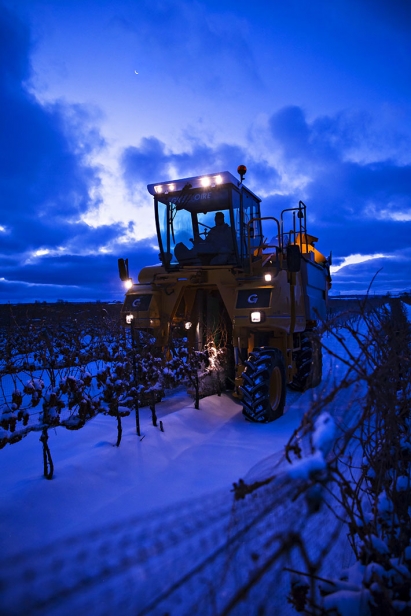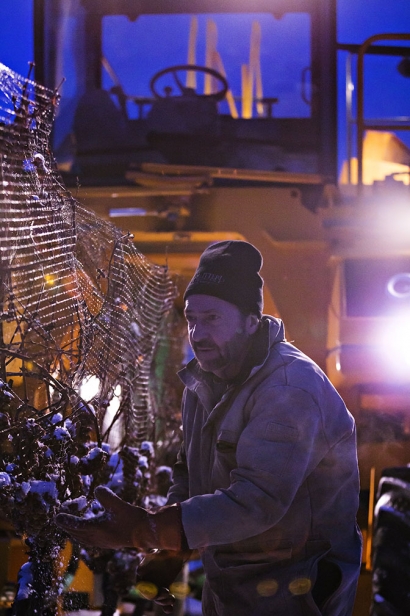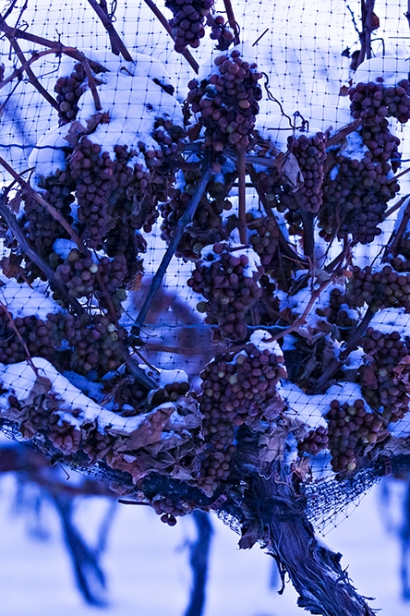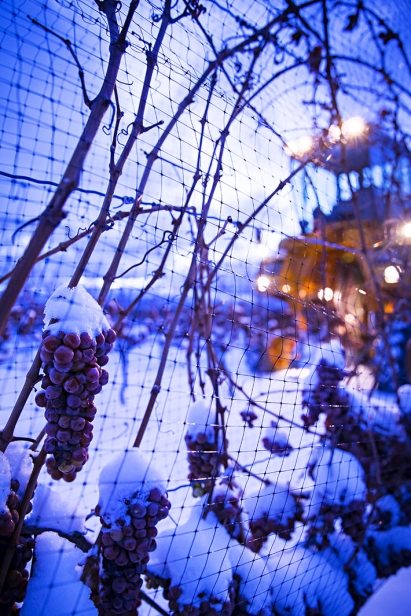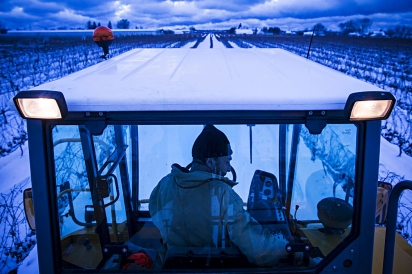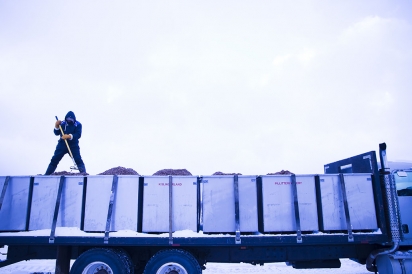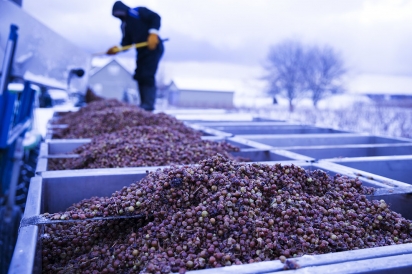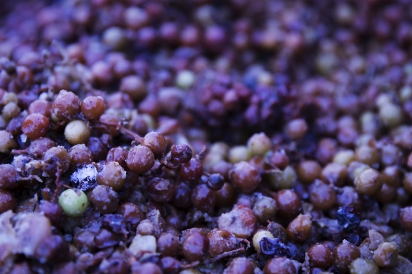Under the Night Sky
There's a loud “crunch” when Jamie Slingerland’s boots hit the hard-packed snow. The hairs in his nostrils stick together in the sub-zero temperatures. And if you listen carefully, you can hear the sound of coyotes howling over their prey in the distance.
It’s the middle of the night in early December and Slingerland is playing the role of meteorologist, grape expert and harvester all at the same time. This can only mean one thing: It’s icewine season.
Slingerland, director of viniculture at Pillitteri Estates Winery, is in a race against time and Mother Nature. If temperatures warm up, the grapes won’t meet the standard for pressing and creating the sweet elixir. If the conditions get much colder, those same grapes won’t have enough juice to give — meaning he’ll have to wait another few days. But even an hour — the difference between a 2 a.m. and 3 a.m. start time — can turn a “go” decision, into a “no-go.” If the wind changes direction or the clouds roll in, creating an insulating barrier over the vineyard, temperatures could fluctuate.
And every morning, yet another impediment. Just before sunrise, hungry starlings arrive — a few at a time at first, then in flocks of thousands, he says.
“They destroy 50 berries for every berry they eat,” Slingerland explains.
And nothing seems to be able to stop them, “no matter the netting, the propane canons, the foil ribbon” or people with starter pistols and flares — the ravenous birds still arrive. Slingerland says the scene is “reminiscent of a Hitchcock movie.”
By the first of January, once all other food sources are gone, the birds can eat up to one per cent of the crop every day.
The first icewine is believed to have been made in Germany, in the late 1700s. Freezing temperatures arrived before the vineyards could be harvested, but the winemakers (legend has it they were monks) persisted and pressed the frozen grapes, turning them into a sweet wine.
Today, though Germany and its neighbour, Austria, continue to make icewine, they produce much less due to warmer and more temperate European winters. When German immigrants arrived in Canada in the early 1970s, they brought their icewine traditions with them — creating a path for Ontario and British Columbia to lead the way in worldwide icewine production.
To make VQA icewine, a winery’s grapes must be registered with VQA Ontario inspectors in November. The variety, acreage and estimated tonnage is checked. In the Niagara region, the predominant varieties for icewine-making are Riesling, Vidal and Cabernet Sauvignon or Cabernet Franc. Then, it’s a waiting game.
Regulations state temperatures must fall below minus eight degrees Celsius to harvest, but most winemakers will tell you the “sweet spot” is between -10C and -12C degrees.
Yet temperature doesn’t tell the whole story.
“I still reach with my glove through the netting to the grape bunches on the vine and squeeze them by hand,” says Slingerland when asked how he knows the time is right. “Two or three drops of sticky juice on my glove is a good indicator that the grapes are ready to pick.” A wet glove means they’re too soft and a dry glove tells him they’re too cold.
Once picked, icewine-makers press the grapes and measure the juice’s sugar levels. The aim is to get between 35 and 39 degrees Brix — the term for sugar content in a liquid. High sugars can make fermentation difficult, which is why icewine tends to be lower in alcohol than your average table wine.
For Slingerland, whose family began farming grapes and fruit in Niagara-on-the-Lake back in 1783, the wine industry runs deep in his roots. He learned traditional winemaking methods from his father-in-law, Gary Pillitteri, in the early 1980s. He has since won many accolades for his work, including from the time he spent on the Verona Appassimento Project — a project dedicated to developing appassimento-style wines in Ontario, a form of winemaking where harvested grapes are dried out to concentrate sugars and flavours.
This year will mark the 30th the Niagara-on-the-Lake veteran has harvested grapes for icewine. During those three decades, not one harvest has been the same.
This time around, Slingerland and his team were able to make a first pick before Christmas — something that happens only 30 per cent of the time.
Prolonged stretches of cold temperatures usually don’t come until later in the season, or in January. He vividly recalls clinking glasses at midnight on many New Year’s Eve nights, then quickly jumping into standby mode for harvest. Most of the picking, he estimates 90 per cent of the time, is done within the first two weeks of January.
Sue-Ann Staff, the owner and winemaker at Sue-Ann Staff Estate Winery in Jordan, also recalls a New Year’s Eve harvest — her very first in 2007.
“We had two really good days of harvesting on New Year’s Eve and the day before,” she says. She was able to get about 40 per cent of the crop off in those two nights. But waiting for the next cold stretch was a testament to the winemaker’s patience — and risk threshold. The next adequate days to pick came on February 14 and March 23 — the latest “anybody has ever picked.”
The grapes were “quite dehydrated” by that point, she explains, and she was only able to press about 70 per cent of the juice she normally could. If those cold stretches hadn’t come, Staff says the grapes would have been a write-off or picked for lesser-style dessert wines, such as a late harvest.
Staff, who’s been nicknamed the “Ice Queen” for her work with icewine when she was Pillitteri’s winemaker and now at her own winery, admits icewine making is a “huge gamble.”
“You don’t know when the right day is going to come, you may have to drop everything in life even over the holidays,” she says. This year, due to business travels in Asia, she wasn’t able to get the grapes off in time before Christmas, something she says she may regret.
For Paul Speck, president and co-owner of Henry of Pelham Estate Winery in St. Catharines, the icewine gamble depends on the size of the market.
“The wine business is risky all the time,” he explains. “This is agriculture, if you can’t handle a risk in Mother Nature then you shouldn’t be in the wine business.”
For Henry of Pelham, which celebrates 30 years of winemaking in 2018, the first icewine vintage came in 1989. Speck recently uncorked one of those almost three-decades-old bottles. He described it as full of classic fruit flavours such as apricot, only riper and with plenty of retained acidity.
Drinking the wine reminds him that “many, many years ago I stopped worrying about the weather because certain things I can’t change in my life. So, you just have to give up worrying about it and hope everything works out.”
The shift to mechanical harvesting is one change that has removed some of the risk. Though some smaller wineries will still pick by hand, most operations — including those of Slingerland, Staff and Speck — use large, single-person mechanical harvesters to remove grapes from the frozen vines.
Slingerland recalls a time when there would be 90 people in the field, working around the clock, removing grapes and placing them in boxes on the ground. The ground, being warmer than the air, added another element of precariousness to the harvest — the boxes needed to be removed quickly to prevent thawing.
Today, Slingerland operates the harvester himself and works with a small crew of four. Though not as romantic as the image of hand-picking bunches of grapes under a full moon with snow blanketing the surroundings, it is a far more effective way of ensuring quality and speed.
The large machine shakes the grapes off the vines, which “sound like stones hitting the walls of the harvester” Slingerland describes.
He sits perched six feet above the grape rows, able to see the lights from a dozen other harvesters in the distance doing the same thing.
“It’s kind of an unspoken bond between brothers at work in the early and long hours of the night that few people will ever experience,” he says
The effort and the risk involved almost doesn’t seem worth it when you look at the numbers. For its 2017 harvest, Pillitteri estimates harvesting 1,500 metric tonnes of frozen grapes, which will make one-million small (200 or 375 millimetre) bottles. To put this in perspective, yields for icewine are only 15 per cent of the expected yield for table wines.
But all that work does pay off, just not necessarily at home in Ontario.
“Canada is more famous for its ice wine in wine circles than it is for hockey in hockey circles,” argues Slingerland, adding that icewine can either make or break their business.
Pillitteri sells icewine in 40 countries and exports up to 60 per cent of its icewine, much of it to Asia — making it one of the global leaders in icewine trade.
Staff, who recently returned from a trip to China and Vietnam, says Asia is the biggest market for icewine in the world. “It’s highly prized and a very prestigious gift to give,” she explains.
For Speck, icewine has become synonymous with Canadian culture around the world and “what it means to represent Canada... maple syrup, hockey, moose and icewine... they go together.”
So great is the international love affair with Canadian icewine, that fraudulent bottles have now entered the market. After all, imitation is the sincerest form of flattery.
Staff recalls travelling to Asia and being surprised at the low price point on some bottles of Canadian ice wine, only to find they were fakes upon closer inspection.
Little markers such as Toronto having a “w” on the end, or VQA missing a letter, were easy for her to spot, but perhaps not so easy for eager consumers. Bootleg icewine has been made in different ways, from freezing grapes cryogenically to adding sugar to wine.
Staff, a fifth-generation winemaker, has even been invited to Taiwan to hold a session for media and professionals to spot fraudulent and inauthentic bottles of icewine. “Of course, the authentic guys come up on top,” she affirms.
Even though the rest of the world may love icewine more than Canada, Slingerland wants locals to give it a chance.
One of his favourite ways of serving it is by slicing a local Niagara peach, putting it in a frying pan to warm up, drizzling some ice wine on top then serving it over some grated chocolate with fresh whipped cream. If he’s using a red icewine, he switches up the fruit so it shares some of the wine’s characteristics, mostly fresh berries.
He also suggests drinking icewine in a brandy sniffer to help open up the aromas — adding that drinking icewine straight from the freezer actually does the drink a disservice.
“If it’s too cold, you won’t be able to taste a lot of the flavours,” he says. The only reason to drink wine ice cold is if it’s a bad wine because “you’re not going to taste anything.”
For Staff, picking her favourite way to drink icewine is a toss-up.“You have this amazing contrast between the sweetness and acidity of the wine and then the sharpness of the cheese — it’s like a yin and yang,” she says of her favourite pairing: Roquefort cheese and icewine.
She also loves “anything chocolate” with a red icewine, like a Cabernet Franc. A dish of sweet potato gnocchi with sage, served alongside a Vidal icewine is another winner.
For Speck, salty cheese and icewine is also an ideal pairing — but his favourite way to drink the sweet syrup is in a cocktail, by adding a little icewine to a flute of Henry of Pelham’s Cuvée Catherine Brut.
Despite the hard work, freezing temperatures and reliance on factors beyond human control, icewine consumption will continue to grow, according to latest market reports.
“We will take pride in a cold night’s work,” says Slingerland, describing the feeling at the end of a harvest.
The process can even imprint a memory that lasts for 30 years.
“The first time ever, the wind was blowing so hard, the whole family came out and volunteered and everyone in the neighbourhood came out because it was just so new at the time,” describes Speck of his first icewine harvest. It was so cold, one of the neighbours came out with hot apple pies.
“So, we ate hot apple pie and slowly drank brandy, just to warm up.”
This season, everyone is eating their pies and drinking their brandy indoors. Mother Nature played nice and harvest was completed before the end of January. Now, another waiting game — as the wines ferment and await being bottled.
Henry of Pelham Estate Winery
1469 Pelham Rd., St. Catharines, Ont.
henryofpelham.com, 905.684.8423
Pillitteri Estates Winery
1696 Niagara Stone Rd., Niagara-on-the-Lake, Ont.
pillitteri.com, 905.468.3147
Sue-Ann Staff Estate Winery
3210 Staff Ave., Jordan Station, Ont.
sue-annstaff.com, 905.562.1719



